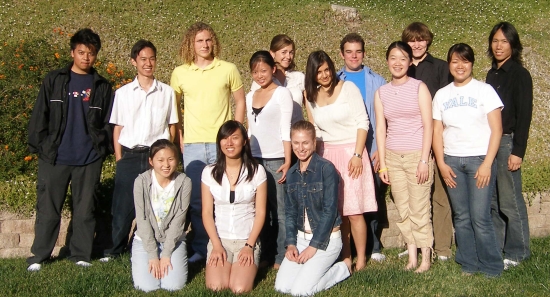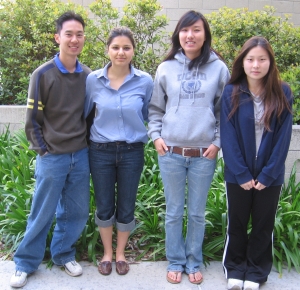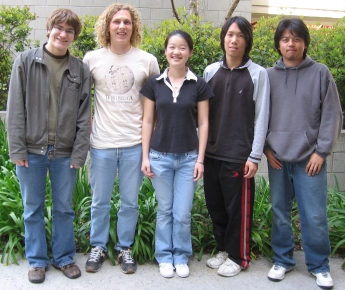Calit2 Helps UCSD Undergraduates 'PRIME' For The Future
By Maureen C. Curran
San Diego, CA, June 22, 2006 -- Fourteen UCSD undergraduate students began summer educational adventures yesterday, boarding airplanes to four destinations in Asia and Australia. They are participants in Pacific Rim Undergraduate Experiences (PRIME). PRIME is an unique program that gives undergraduates the opportunity to do collaborative research at host institutions in the Pacific Rim.
|
The goal of PRIME is to better prepare students to work in the global economy and the research environments of the future. This is the third year of a three-year pilot program funded by the National Science Foundation (NSF), with additional support from Calit2. The program has had many successes, among them the international collaborations that PRIME students have enabled.
|
A 'PRIME' example: "In 2004, we established an interesting and useful collaboration with David Abramson's lab at Monash University, Australia, which resulted in a real exchange of data and knowledge," recounts Anushka Michailova, a senior researcher in Andrew McCulloch´s lab in the Jacobs School's Bioengineering department.
"Our bioengineering students have had a great time in Melbourne the past two summers using novel grid computing technologies to develop and optimize sophisticated computational models of cardiac cells," says Andrew McCulloch, professor and chair of the Bioengineering department. "This has helped our lab develop new and more realistic multi-scale models of the heart in health and disease."
"From our point of view, the program has been a wonderful success. This is a real example of e-Science/e-Research at work, where different communities work together in ways that were not possible before," explains David Abramson, professor at the Clayton School of Information Technology, Monash University, in Melbourne. "The students have integrated two different technologies from opposite sides of the globe and developed novel solutions to some important problems."
John Colby was one of the inaugural PRIME students who went to Melbourne in 2004 and worked in Abramson's lab. He is thrilled with his experience: "I can say without question that my involvement with PRIME, more than any course I took, helped give me the level of professional understanding and maturity necessary for academic success and beyond." He just graduated from UCSD last week with a double major in Premedical Bioengineering and Molecular Biology. He has accepted a full Medical Scientist Training Program fellowship at UCLA. His training towards an MD and a PhD in Biomedical Engineering begins this summer. Colby adds, "Furthermore, when interviewing for graduate schools, every program I visited, without exception, was impressed with the unique opportunities that PRIME offers to undergraduates."
"Through our students, the program has created a very positive impression of US students at the host sites," states Peter Arzberger, PRIME co-organizer and director of the Life Sciences Initiative at UCSD. "At one of our host sites, Osaka University, the faculty has modified the program and put it into a larger context of a complete educational experience, including graduate students. This is very exciting for us because it reinforces the model developed by PRIME. It affords us the benefit of students coming to UCSD, and it allows the students in the PRIME program to continue interacting with Osaka University students." This new program - the Pacific Rim International UniverSities (PRIUS) - is funded from a proposal competition.
|
"Students majoring in various engineering disciplines at UCSD's Jacobs School of Engineering dominate the awardees. However, students from outside of engineering are participating this year as well," notes Gabriele Wienhausen, the principal investigator on PRIME and one of three program coordinators. Wienhausen continued: "This is the first year where there are more women than men." Each student lives for nine weeks in the host country and works with mentors there, as well as with mentors at UCSD. See sidebar for details on the PRIME 2006 students and their research plans.
The host cities are Osaka (Japan), Hsinchu and Taipei (Taiwan), Beijing (China), and Melbourne, Australia. The host organizations are all connected to the Pacific Rim Applications and Grid Middleware Assembly (PRAGMA) collaborative program, a Calit2 partner.
There are three program organizers for PRIME: PI Wienhausen, who is also the founding provost of Sixth College at UCSD; Arzberger who is also PRAGMA's principal investigator and director of the National Biomedical Computation Resource (NBCR); and Linda Feldman, senior analyst of UCSD's Academic Internship Program.
2006 PRIME Students
Japan
- Robert Sy, Visual Arts Media with Computing
- Ao 'Cathy' Chang, Cell Biology and Biochemistry
- Daniel Goodman, Bioengineering and Bioinformatics
- Marshall Levesque, Bioengineering and Biotechnology
All four UCSD undergraduates will work with professor Shinji Shimojo, director of the Cybermedia Center at Osaka University. Shimojo is a world-renowned scientist who is the principal investigator on a major award to build a Biogrid in Japan. Assisting in this collaborative effort will be Susumu Date, an assistant professor in Osaka's Graduate School of Information Science and Technology.
Robert Sy plans to develop multiple visualization walls utilizing computer displays. UCSD mentor Tomas Molina is a researcher with the National Center for Microscopy and Imaging Research (NCMIR). About the summer, Robert says "I am excited to be working alongside people with different experiences and skills from mine in terms of culture and major. I also look forward to overcoming the obstacles I expect to meet."
Cathy Chang will focus her research on Drug Database and Docking. UCSD mentor Philip E. Bourne is a professor of Pharmacology.
Daniel Goodman will evaluate and improve DOCK software through screening analysis, also with UCSD Pharmacology's Bourne.
Marshall Levesque will be working on DOCK as well, with the goals of identifying new docking sites between proteins of interest and screening against ligands to find those that may inhibit enzymatic activity. His UCSD mentor, Jason Haga is in the Jacobs School's Bioengineering department.
Taiwan
- Stephen Chen, Engineering Physics
- Mahboubeh Hashemi, Bioengineering
- Bryan Lin , Structural Engineering
Stephen Chen and Mahboubeh Hashemi will be traveling to the National Center for High-performance Computing (NCHC) in Hsinchu, Taiwan, under the guidance of its Grid Computing Division manager Fang-Pang Lin. Both will work with Lin and UCSD mentor Gabriel Silva of the Jacobs School's Bioengineering department.
Stephen Chen will work to increase the resolution of tile display walls used to present video streams and stream videos simultaneously to multiple research facilities in the Pacific Rim. Mahboubeh Hashemi will collaborate on research in the computational techniques of automating identification of cell locations via image-processing procedures.
Bryan Lin will be traveling to the National Center for Research on Earthquake Engineering (NCREE) in Taipei, Taiwan. He will program and link the Network for Earthquake Engineering Simulation (NEES) Real-time Data Viewer (RDV) to a PC for monitoring and link the RDV to the test environment, which will allow anyone with Internet access to view test results rather than restricting the results to those present in the research facility. He will be assisted by NCREE's director, Keh-Chyuan Tsai, and UCSD mentor Chia-Ming Uang of the Jacobs School's Structural Engineering department.
Australia
- Angelina Altshuler, Pre-med Biomedical Engineering
- Celia Croy, General Biology
- Iwen Wu, Bioengineering and Biotechnology
- Noah Ollikaninen , Biology, specialization in Bioinformatics
All four students will perform research at the School of Computer Science and Engineering at Monash University in Melbourne, with director and professor David Abramson, a well-respected researcher in software for cyberinfrastructure and a developer of Nimrod/G.
Angelina Altshuler and Iwen Wu will assist in the development of more stable ionic-metabolic models of rabbit and human ventricular myocytes. Their UCSD mentors Anushka Michailova and Roy Kerckhoffs are senior researchers in the lab of professor Andrew McCulloch, chair of the Jacobs School's Bioengineering department.
Celia Croy will work on a combination of studies involving computational analysis of biological structures using the GAMESS/APBS/NIMROD programs. UCSD mentor Kim Baldridge is from the San Diego Supercomputer Center (SDSC) and a professor at the University of Zurich's Organic Chemistry Department.
Noah Ollikainen aims to build software that easily allows AutoDock users to distribute a set of docking jobs on a local network or grid with UCSD Pharmacology's Bourne.
China
- Lily Cheng, Pre-med Bioengineering & Pharmacological Chemistry
- Elaine Liu, Aerospace Engineering
- Danjing 'Lisa' Zhao , Pre-med Bioengineering
All three will conduct research at the Computer Networking Information Center, Chinese Academy of Sciences (CNIC, CAS) in Bejing, China, under the mentorship of Baoping Yan and senior researchers Kai Nan and Zhonghua Lu.
Lily Cheng will be working to predict new epitopes, fragments of a virus that are recognized by the body's immune system and elicit an antigenic response, for the current Avian influenza virus using a combination of bioinformatics, molecular dynamics and docking techniques on the supercomputers of the SCCAS, CNIC with CNIC's Zhonghua Lu. Her UCSD mentor is Wilfred Li.
Elaine Liu plans to create a software application to visualize astronomical data from China to San Diego using an OptIPuter tiled display wall, with CNIC's Nan. UCSD mentor Jurgen Schulze is a postdoctoral researcher at Calit2 and member of the OptIPuter team.
Lisa Zhao will examine the biological structure of the H5N1 virus Hemagglutinin (HA) protein in an effort to understand the effect of mutations on host selectivity. In addition, she will learn how to use the scientific data grid technology at CNIC to manage large virtual screening experiments, under the direction of CNIC's Nan and UCSD's Li. Says Lisa: "I am excited to meet my coworkers and hope to accomplish a lot by the time I return."
by Maureen C. Curran <Kristin Miles and Teri Simas contributed to this article.>
Media Contacts
Contact: Teri Simas, PRAGMA Program Manager, 858-534-5034, tgraysimas@ucsd.edu
Related Links
Pacific Rim Applications and Grid Middleware Assembly (PRAGMA)
Pacific Rim International UniverSities (PRIUS)
Computer Network Information Center (Beijing)
Cybermedia Center of Osaka University
Monash University
National Center for High-performance Computing
Related Projects
OptIPuter
Pacific Rim Undergraduate Experience




